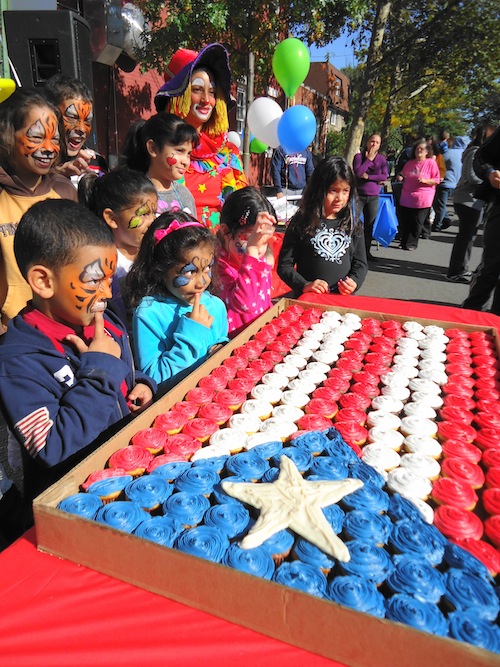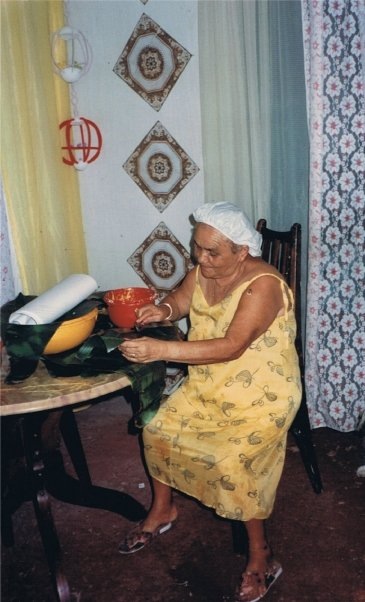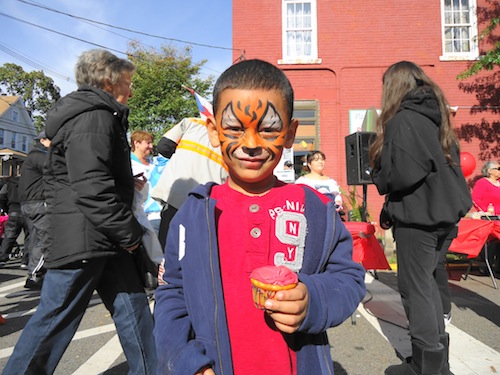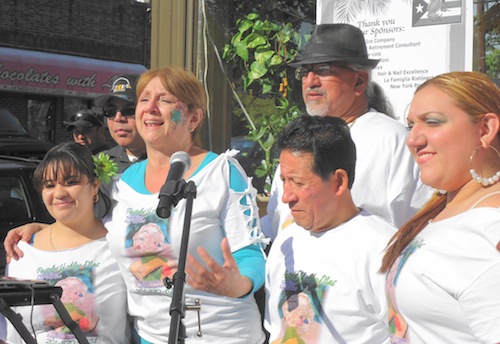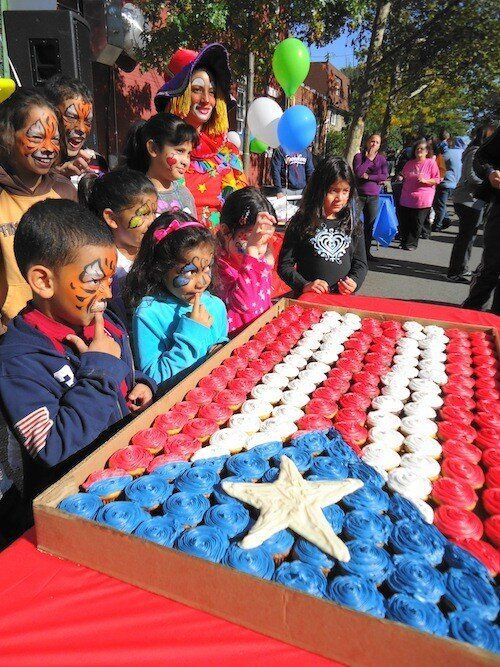
Edna and Joanne Velez.
As party-goers, diners, friends, family (and the odd journalist or two) walked towards Pasteles Y Algo Mas, in Ridgefield Park, New Jersey, the Puerto Rican DJ was playing musica latina loud enough to move hips four blocks from the restaurant.
In fact, he was "spinning" owner/chef Edna Velez's favorite tune, "Pedro Navajas," by Ruben Blades.
Velez was celebrating the first anniversary of her tiny comida criolla, or humble, island eatery, and Bergen County, New Jersey's Puerto Rican community was out in full force, devouring pasteles de guineo y yuca -- as well as red, white and blue-frosted cupcakes that formed a huge "cupcake cake" in the shape of the Puerto Rican flag.
Children, their faces painted by local clown and artist Ivonne Marcela Ramirez were dancing, well-fed, smiling, deafened by the blaring Salsa, and tethered to balloons.
Face-painting and cupcakes at "Pasteles."
Their parents were eating, dancing, and tearfully embracing Edna and her daughter, Joanne, who, a year ago, on half a wing and a fervent prayer, brought this tiny storefront restaurant into being.
And it all came about because of Edna's pasteles, those divine and complex bundled-in-banana-leaves-and-tied-up-in-parchment savory packets conjured from any number (and proportions of) such treasured Puerto Rican foodstuffs as green banana, green plantain, yautia, calabazas, annatto oil, pork shoulder, sofrito, and/or sazon.
Not just anyone can make pasteles, a traditional island specialty served at holiday feasts (and no one of Puerto Rican ancestry, it seems, can long live without consuming them). But who, any more, knows how to make them, in their several iterations, and who has the time?
Edna Velez always made the time, even if it meant cooking up hundreds of the little delicacies in her basement kitchen after returning from her day-job at Columbia University.
"A year ago," Edna said, "I was making hundreds of pasteles at my home in Bogota, New Jersey." She'd spent 22 years at Columbia, employed as an Executive Assistant/Departmental Administrator in the office of the Vice President for Public Affairs but, laid off during the recession, she began to see her hobby as perhaps having more potential than her office job.
After decades of commuting into Manhattan, she took a deep breath, made a leap of faith, gathered her diaspora Puerto Rican family together, and opened a restaurant. "I took every penny I had from my university severance package, even dipping into my 401K," she said.
But, if she built it, would they come?
Velez was born in New York City, the daughter of Edna Rivera and Ricart Gonzzales of Lares, Puerto Rico, who immigrated to the U.S. in the 1940s. Before settling down, the family did some to'ing and fro'ing between Lares and New York, and so Velez learned the fine art of traditional Puerto Rican cuisine in the kitchen of her mother-in-law, whom she calls Mami Pura. "I was 16 when I got married," said Velez, "so Pura Medina was my teacher. She was an excellent cook, and I and my husband were living with her in Lares at the time.
Mami Pura.
"She and I would go to the market in town very, very early, La Plaza del Mercado, where the farmers came in from the countryside with all their vegetables--green bananas, plantains, cabasa, cilantro, garlic, parsley -- lots and lots! -- and their freshly butchered meats. There was fresh pork, chickens killed right there on the spot, goat, and rabbit.
"We rose early to be sure to get the very best, the freshest, of everything, and then, home around 10 or 10:30, we would clean the vegetables, wash the meats--which we would later marinate; the goat, in red wine -- and begin to prepare cabrito en fricase and sofrito."
Said Velez, "At Columbia, I actually lost my job twice: first, in 2009, due to the recession; then, in June of 2011. That was when I decided... enough! We're going to cook pasteles full-time."
Edna, an auburn-haired firecracker with a mother's, a grandmother's--now, a great-grandmother's -- all-enveloping energy, then pointed at her daughter, Joanne Velez. "She's the one!" she said. "Joanne here said, 'Mom, if you're turning out pasteles for 150 people at Columbia already, let's get ourselves up out of this basement.'"
Edna and Joanne called on Uncle Ricart, Edna's older brother from Colorado, to build the restaurant from scratch. He told his sister that if she'd pay his air fare and feed him, he'd stay till the work was done. A year later, Ricart came back to take pictures of Pasteles Y Algo Mas's first birthday party.
They built it. And the people came. "And came and came and came," said Edna.
Happy little "Pasteles" customer.
"When I was a little child bride back in Lares," she said, "I would constantly and repeatedly ask Mami Pura, 'Why do you put milk in the green bananas?' and 'Why do you burn the banana leaves over the fire?' and 'Why, when we're making pasteles, do you use pumpkin, if we're supposed to use bananas?' I took mental notes for years and, now, when I make pasteles in New Jersey, I, too, use some pumpkin. Mami Pura's little bag of culinary tricks is all in my head now."
Edna added, "The delivery guy comes in now, every day, asking, 'Mami, what's for dinner today?' I built this place so people would come and feel as though they were coming home."
For almost everyone who walks in departs with take-out, or dessert to eat later, and a big hug from Edna.
Edna's mother-in-law died in the late 1980s. Edna said, "Now it's my responsibility to carry on her traditions. Mami Pura used to make the family holiday meals, when all of us came to gather around her table. Today, the art of Puerto Rican cooking is dying, slowly fading. It's labor-intensive and no one wants to put in the hours."
She continued, "Joanne and I are here five days a week, Tuesday through Saturday, and we begin putting together the day's offerings at 7 a.m. five days a week. Customers begin appearing at our locked door an hour before opening time: 'I'm hungry, Mami!' Then, by 5 p.m., we're out of everything. 'Oh, just scrape the bottom of that tray,' say the latecomers."
Velez serves up a different menu every day. "I freeze nothing," she said. "I make things my customers' mothers and grandmothers used to make. I'm like a mother who spoils her children rotten. One customer, who works for a local business, is here every day, and so I know exactly what he wants: fried green plantains, nice and crunchy, with vinegar, oil and garlic dipping sauce; and the crackling roast pork skin."
Velez dreams now of enlarging her comida criolla, expanding so that whole families can join her for sit-down, home-cooked, Puerto Rican meals. "I don't want to go huge," she said. "I don't want to lose the cozy essence of Pasteles... but there are all these people to feed!"
... the same people who are now also begging her to begin teaching her craft; teach young cooks to assemble pasteles before the secrets are lost.
Some of Edna's "familia."
"In March," said Velez, "I went back to Puerto Rico for the birth of my great-grandson and found that they're reinventing traditional dishes such as mofungo, which usually features mashed green plantains. Now, you'll find mofungos made with mashed sweet plantains (maduros), or cassava (yuca) -- which is totally new. And I do like to keep up, so I now serve these variations in New Jersey."
This great-grandmother intends to keep cooking and learning and growing.
"Pasteles Y Algo Mas was and is a labor of great love," said Velez. "Without my family's support, it would never have come into being and, without the families who are now my customers, I wouldn't be here a year later. We all are... una grande extension de nuestra familia."
One big happy, hungry family.
Two Recipes from Edna Velez
Mofongo de Chicharron
Mofongo,a dish of garlicky mashed plantains, is one of the most popular dishes in Puerto Rico. The classic way to serve mofongo is in the mortar (pilón) in which it was mashed.
Ingredients
4 Green plantains, peeled and cut into rounds on the diagonal
3 tablespoons of olive oil
2 garlic, minced
1/2 Cup of pork cracklings (chicharrones)
Salt, to taste
2 Cups canola oil (for frying the plantains)
Preparation
Soak the plantain pieces in a bowl of salted water for about 15 minutes. Drain well. In a deep frying pan, pour 2 cups of canola oil and heat over medium flame. Working in batches, fry the plantain slices until they are golden and cooked throughout but not browned (if they brown, you have over cooked them), approximately 10-12 minutes. Combine the minced garlic with the 3 Tablespoons of olive oil and add salt to taste; mix well. This will be your mojo mix. Add the plantains, garlic sauce (mojo mixture), and the 1/2 Cup of pork cracklings into a large mortar (pilon) and mash with a pestle (maceta) until fully mixed together. Using moistened hands, form into 3-inch balls and serve warm.
Serves four to six.
Flan de Leche
Puerto Rico's answer to crème caramel.
Ingredients for the Batter
1 can Carnation Sweet Condensed Milk (14 ounces)
1 can Carnation Evaporated Milk (12 ounces)
Sugar, 1 Cup
Vanilla extract, 2 teaspoons
6 large eggs
Ingredients for the Caramel
Sugar, 1 Cup
You'll Need
1 small round aluminum pan
1 pot large enough to hold the aluminum pan comfortably
Preparation
Preheat oven to 350 degrees. In a blender, pour all batter ingredients and beat lightly until everything is incorporated. Add the vanilla. Melt sugar on stove until lightly brown to make the Caramel (make sure not to burn the sugar; otherwise your Caramel will be bitter). Add Caramel to round aluminum pan and rotate, making sure you cover the sides as much as possible. Add batter mixture to the pan and cover with aluminum foil. Fit round pan into the large pot and fill pot halfway with water (make sure not to overdo the water because it will water down your flan when it starts to boil). Bake for 1 hour or until your knife comes out clean. Let cool, then refrigerate for about 1 hour before serving.
Serves 8 to10.
. . .
Pasteles Y Algo Mas, 63 Ridgefield Avenue, New Jersey 07660; 201.870.6151.
Photo of Mami Pura, courtesy the Velez family.
All other photos by Elizabeth Boleman-Herring.

